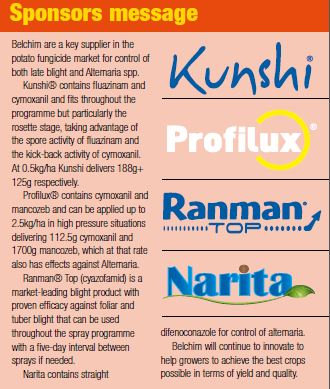
Potato blight is arguably arable farming’s most destructive plant disease – the only one to have ever caused widespread crop loss leading to famine in the British Isles, as it did during the Irish and Highland blight epidemics of the mid 1840s. It currently costs the industry around £55 million/yr to keep the disease under control.
Recent developments in the blight population mean that it’s now a tougher disease to control than it was a decade ago. Key to effective management is good monitoring of risk and outbreaks and hygiene, as well as a control programme that starts at the right point in the season and maintains tight intervals between fungicide applications, says Dr Ruairidh Bain of SRUC. But behind any effective strategy lies a good understanding of the pathogen you’re dealing with.
What is potato blight?
Often referred to as late blight, the disease is caused by the pathogen Phytophthora infestans that spreads fast, with a life cycle of just three to eight days, depending on genotype and conditions.
It’s spread mainly by wind-borne spores (sporangia) that infect the leaves and stems of potato plants. Under cooler conditions, the sporangia mainly release zoospores, which can be washed down through the ridges and come into contact with the potato tubers, resulting in tuber blight.
The typical leaf symptoms of the disease are irregularly shaped lesions that enlarge rapidly, turning the foliage a dark brown. Unchecked, the complete crop canopy can become infected and collapse. Infected tubers develop fox-red or dark marbling of the tuber tissue, and can quickly decay through secondary bacterial soft rotting to a foul-smelling mush.
How is it spread?
The pathogen predominantly reproduces asexually – the greatest number of wind-borne spores is produced under warm and humid conditions and the pathogen needs green plant material to develop. When the weather is the right combination of temperature and humidity, known as a Smith Period, this is when blight will spread fastest and crops are most at risk.
However, in recent years, blight has been found to spread before Smith Periods are triggered. Local Smith Period information can still be useful but it’s critical to know that the long-established temperature and humidity thresholds will miss some high-risk periods. The industry is currently revising the system of monitoring the blight threat, and new thresholds are close to being agreed.
Until now, Smith Period information from BlightWatch (www.blightwatch.co.uk) has been provided after high-risk days occurred. For the 2016 season, BlightWatch will provide forecast data so that Smith Period predictions will be for the coming 24 hours instead of the previous 24 hours. The service will also make a prediction out to 48 hours, based on the forecasts for the current day and the next.
How has the pathogen changed?
The blight population is made up of a number of different genotypes, grouped into two mating types, A1 and A2. Until around 2006, the A1 mating types were dominant in the UK. But the newer A2 mating type, first identified in the 1980s, then rose to dominate the population, which is monitored through a research programme funded by AHDB Potatoes.
Currently, the population is relatively stable, with two dominant genotypes – 13_A2 and 6_A1 – making up 80-90% of the population (see panel on pxx for latest information). They are relatively aggressive, so the amount of damage they cause to crop foliage is severe compared with many other genotypes. What’s more, they are relatively fit, so survive well over winter and can start to spread early, which explains how they’ve come to dominate the population.
A key concern since the A2 mating type rose to prominence is that the two genotypes can reproduce sexually and produce oospores. These can survive in the soil for up to four years, and in other European countries have been responsible for early and severe blight outbreaks.
Although no oospores have yet been identified as starting an outbreak in the UK, it’s generally considered sexual recombination is probably taking place. The diversity of non-dominant unique genotypes makes this likely, although this hasn’t yet led to a new dominant genotype, and new ones that are identified disappear quickly.
In 2010 and 2015 – seasons of notably low blight incidence – there was a relatively high proportion of non-dominant genotypes. It’s not yet clear if this greater diversity in the population in these years represents a gradual shift to a sexually reproducing population, or simply that these miscellaneous genotypes were less masked by 13_A2 and 6_A1 than in moderate to severe blight years.
How do you prevent blight?
The consequences of the shift in blight populations are that blight will tend to come into the crop earlier and hit harder. So vigilance early on and planning are crucial. Growers must stay alert for signs of blight and control sources of infection, such as outgrade piles and volunteers, destroying any green growth before it becomes infected. It also helps to know the blight health status of seed stocks.
As well as monitoring your own crops, make use of a good blight monitoring service, to keep yourself abreast of disease developments and weather-based risk. This can be achieved through AHDB Potatoes’ free Fight Against Blight (FAB) service.
There is concern that growers fail to consider disease-resistance ratings when planning fungicide programmes. Research has shown there are significant differences, as well as fungicide savings that can be made, by growing a variety with a blight rating of 5 compared with a 3 – a typical disease rating for the current UK crop.
How do you build a control programme?
Although growers are dealing with a different type of blight, the current fungicide armoury, used well, will still bring good control. The difficulty is that these aggressive and fit genotypes will mercilessly take advantage of any lapse in a robust strategy.
There are some key principles that ensure a blight control programme remains effective:
- Start early – The more aggressive genotypes 13_A2 and 6_A1 are generally the first to appear in the crop. Assume these are the ones you are tackling.
- Gauge the risk – the timing of fungicide application in relation to high-risk weather is key. Fungicides give more protection if applied just before a high-risk period. Curative fungicides prevent more early infections from developing into lesions if applied shortly after a high–risk period.
- Tight timings – Spray programmes should build well timed applications around a realistic threat-based blight control strategy. Given these genotypes’ aggressiveness, there is now much less scope to extend spray intervals beyond a maximum of seven days. An even tighter interval may be required to get on top of a blight infection.
- Keep going – There’s no point in keeping blight out of the canopy for almost the whole growing season if it’s then allowed to infect tubers. The economic losses resulting from blight that flares up at the end of the season can be huge, so ensure the crop is protected until there’s no green haulm left. Ensure rapid and thorough desiccation.
Choice of fungicides will vary throughout the season depending on crop growth – whether the canopy is developing rapidly or relatively stable – whether tubers need protection, and blight threat at the time or just prior to application. Key aspects to bear in mind are:
- Efficacy of fungicide combination to protect leaf, stem and tuber
- Level of curative activity needed
- How important rainfastness is.
Another threat to bear in mind is Alternaria, which is increasing in prevalence, particularly in England and Wales, and can result in significant damage. While control of late blight should remain the focus of a control strategy, it’s worth considering whether the fungicides you’re applying will also control Alternaria.
Stay focused from start to finish
Once the blight season starts, Agrii agronomist Nick Winmill will be urging his growers to stay focused until the risk is well and truly over. “It’s important to start programmes early and maintain protection beyond the start of desiccation while there’s green leaf present. Blight can be an unforgiving pathogen – if you take your eye off the ball, it can cost you dearly,” he says.
When planning the strategy, keep in mind varietal resistance. “Many varieties have had their blight ratings re-evaluated in the presence of more aggressive blight strains. It’s unlikely to change what variety you put in the ground – the consumer determines the market, and that’s unlikely to be governed by blight risk. But it’s important to know how susceptible your crop is.”
Once the season starts then a robust disease forecast system can assist in shaping the frequency and timing of blight sprays. “We moved away from using Smith Periods several years ago as this appeared not to be flagging high risk periods either at the start of or during the season,” notes Nick Winmill.
Instead, Agrii uses Dacom’s Forecast-Xtra service in conjunction with its network of more than 180 weather stations to keep tabs on likely high risk periods.
“Following last year’s low levels of blight, the risk of blight in seed stock should be low. But the disease is still likely to start early,” he notes. So he’ll be starting programmes early at, or even before the rosette stage with mancozeb if varietal resistance is good. Otherwise he’ll mix in some cymoxanil for some curative kick-back.
“At the rosette stage I’ll be looking to a cymoxanil plus mancozeb mix, such as Profilux – the advantage of that product is the rate is more flexible if you need to strengthen it. Alternatively, you can use cymoxanil plus fluazinam as in Kunshi.”
Once the crop enters rapid canopy phase, the focus should be on keeping intervals tight and mixing and matching products. “There are many products to choose from and my programmes are built around key active ingredients. Some of the main choices in my view are cyazofamid (Ranman Top), mandipropamid (Revus), fluazinam (Shirlan), fluopicolide+ propamocarb hydrochloride (Infinito) and dimethomorph (e.g. in Invader and Hubble).
“But you need to keep your eye on the weather – if you’re due to spray in 2-3 days’ time and the weather forecast is poor but risk is high, then bring the application forward. If you do get delayed beyond your target interval then consider strengthening the mix with some cymoxanil, for example.”
Once the canopy stabilises, the focus shifts to tuber blight, continues Nick Winmill. “Ranman, Infinito and perhaps Shirlan (fluazinam) are good choices – it’s worth putting some Ranman in with an appropriate desiccant.”
Bear in mind the risk of Alternaria on some varieties. “1500g/ha of mancozeb is a good baseline to maintain as supplied with the full rate of Profilux. As the risk increases, move up through the gears adding an azole, such as Narita (difenoconazole), if you need a bit of curative activity, or bring in a strobilurin-based treatment.”
While product choice is important, he stresses the benefit of starting early, keeping intervals tight and remaining vigilant. “Good coverage is essential – watch around telegraph poles – while controlling volunteers and growth on outgrade piles is a must. If there’s a weakness in your system, blight will find it out, and you’ll be fighting it for the rest of the season.”
Potato blight: top tips
Stay vigilant – Be aware of what the risk is through FAB and monitoring Smith Periods and deal with outgrade piles and volunteers.
Timeliness is key – Start fungicide applications early and keep spray intervals tight.
Protect the tuber – Keep an appropriate programme in place until the threat of infection is definitely over.





